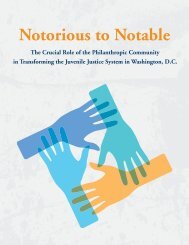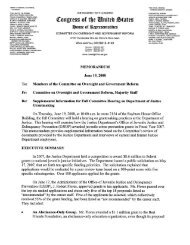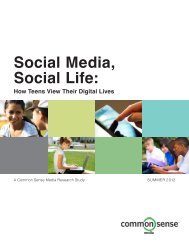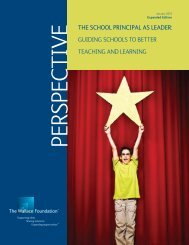Higher Education: Gaps in Access and Persistence Study
Higher Education: Gaps in Access and Persistence Study
Higher Education: Gaps in Access and Persistence Study
Create successful ePaper yourself
Turn your PDF publications into a flip-book with our unique Google optimized e-Paper software.
equirements (62 vs. 55 percent). This pattern was also<br />
found for White <strong>and</strong> Hispanic males <strong>and</strong> females.<br />
Postsecondary School Choice Factors<br />
In 2004, among the 93 percent of high school seniors<br />
with postsecondary aspirations, 67 percent reported that<br />
the availability of courses was very important to them<br />
when select<strong>in</strong>g an educational <strong>in</strong>stitution. Seniors with<br />
postsecondary aspirations also reported the follow<strong>in</strong>g as<br />
very important choice factors: low expenses (36 percent),<br />
the availability of f<strong>in</strong>ancial aid (57 percent), <strong>and</strong> an<br />
<strong>in</strong>stitution’s academic reputation (58 percent). <strong>Higher</strong><br />
percentages of females than males considered all of these<br />
school choice factors to be very important to their school<br />
choice.<br />
However, higher percentages of males than females<br />
reported other postsecondary choice factors as very<br />
important. Among seniors with postsecondary aspirations,<br />
15 percent thought an <strong>in</strong>stitution’s athletic program was<br />
very important, <strong>and</strong> 30 percent thought an <strong>in</strong>stitution’s<br />
social life was very important. <strong>Higher</strong> percentages of<br />
males than females reported athletic programs (19 vs.<br />
11 percent) <strong>and</strong> social life (33 vs. 27 percent) as very<br />
important. A similar pattern was found for Whites,<br />
Blacks, Hispanics, Asians, <strong>and</strong> students of two or more<br />
races for an <strong>in</strong>stitution’s athletic programs <strong>and</strong> for Whites,<br />
Blacks, Hispanics, Asians, <strong>and</strong> American Indians/Alaska<br />
Natives for its social life.<br />
Some 83 percent of students who were high school<br />
seniors <strong>in</strong> 2004 had applied to college by 2006. A lower<br />
percentage of males applied to college than females<br />
(79 vs. 87 percent)—a pattern that held for Whites (81 vs.<br />
88 percent), Blacks (77 vs. 85 percent), <strong>and</strong> Hispanics<br />
(73 vs. 82 percent). No measurable differences between<br />
males <strong>and</strong> females were found for Asians, American<br />
Indians/Alaska Natives, <strong>and</strong> students of two or more<br />
races.<br />
Postsecondary <strong>Education</strong><br />
Enrollment Rates for 18- to 24-Year-Olds<br />
A higher percentage of 18- to 24-year-olds were enrolled<br />
<strong>in</strong> either college or graduate school <strong>in</strong> 2010 than <strong>in</strong><br />
2006 (43 vs. 40 percent), a pattern that held for males<br />
<strong>and</strong> females. In 2010, as <strong>in</strong> every year s<strong>in</strong>ce 1980, a lower<br />
percentage of male than female 18- to 24-year-olds were<br />
enrolled either <strong>in</strong> college or graduate school (39 vs.<br />
47 percent). This pattern was also observed for Whites<br />
(43 vs. 51 percent), Blacks (31 vs. 43 percent), Hispanics<br />
(26 vs. 36 percent), American Indians (24 vs. 33 percent),<br />
<strong>and</strong> persons of two or more races (40 vs. 49 percent).<br />
Entry to Postsecondary <strong>Education</strong><br />
In 2006, about 80 percent of 2004 high school graduates<br />
had ever attended a postsecondary <strong>in</strong>stitution. Among<br />
the graduat<strong>in</strong>g class, 71 percent enrolled immediately<br />
after graduation from high school, <strong>and</strong> 9 percent delayed<br />
enrollment. The percentage of females with immediate<br />
postsecondary enrollment (74 percent) was higher than<br />
that of males (67 percent). This pattern held for White,<br />
Hispanic, <strong>and</strong> Asian students as well. A higher percentage<br />
Executive Summary<br />
Figure 5.<br />
(Figure 31-1) Percentage of 2004 high school seniors who had applied to college by 2006, by race/ethnicity<br />
<strong>and</strong> sex: 2006<br />
Percent<br />
100<br />
80<br />
79<br />
87<br />
81<br />
88<br />
77<br />
85<br />
73<br />
82<br />
89<br />
94<br />
67<br />
84<br />
83<br />
84<br />
60<br />
40<br />
20<br />
0<br />
Total 1 White Black Hispanic Asian American Indian/<br />
Alaska Native<br />
Race/ethnicity<br />
Two or<br />
more races<br />
Male<br />
Female<br />
1<br />
Total <strong>in</strong>cludes other racial/ethnic groups not shown separately <strong>in</strong> the figure.<br />
NOTE: Report<strong>in</strong>g st<strong>and</strong>ards for Native Hawaiians/Pacific Isl<strong>and</strong>ers were not met; therefore, data for this group are not shown <strong>in</strong> the figure. Race categories<br />
exclude persons of Hispanic ethnicity.<br />
SOURCE: U.S. Department of <strong>Education</strong>, National Center for <strong>Education</strong> Statistics, <strong>Education</strong> Longitud<strong>in</strong>al <strong>Study</strong> of 2002 (ELS:2002/2006), “Base-year (2002) to<br />
Second Follow-up (2006).”<br />
Executive Summary xi












